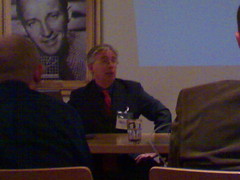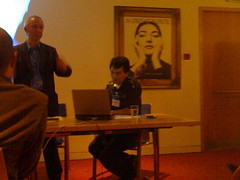160Characters: I-mode
Get me - ever the professional, I was on holiday today but nonetheless wandered up to the NOC/160Characters event on I-mode - and I'm glad I went, it was ace.
Mike Grenville chaired it ably - I'd not attended one of these before but particularly liked the audience introducing themselves before everything kicked off. And the presentations - by a guy called Wojtek from DoCoMo whose surname I missed, and Jag Minhas of O2 - were interesting. I suspect I'm more familiar with I-mode than most people (having read everything I can find out about it for the last 6 years) but there was a lot of info here that I'd not come across before. And the whole event had a relaxed, chatty feel to it. Both speakers dealt amiably with an audience that was at times sceptical (I have to confess I don't quite follow some of the models for how I-mode is way better than alternatives, despite secretly thinking that this might in fact be the case).
A pox on Brighton - I have a very early start tomorrow so dashed out at 9 to get the 9:30 back. Notes follow... my comments are in italics.
Wojtek, Senior Executive Director of NTT DoCoMo, EuropeDisclaimer: he's not in the team specifically supporting UK I-mode launch.
Before coming to UK, he spent 8 years with DoCoMo in Japan; he worked there during the launch, sourcing English-language content for I-mode and 3G before they existed.
Now: 45m subscribers in Japan, 7m outside.
(Is I-mode a way for DoCoMo to claim subscribers and revenue outside of its own customer base? What's the commercial model for licensing I-mode, I wonder - is it in any way tied to the success of I-mode in an individual licensees territory?)
90% of DoCoMo customers are active users of data services; this makes them different from other operators.
80% of I-mode content providers are individuals or small venture companies. There are 85k web sites accessible via I-mode.
Service started with 67 content providers - it was tough convincing the initial ones to invest. Initially large companies in Japan: banks, transportation, entertainment, etc, then they tried to build up more international content. The more content they had, the more appealing they were to users... and the more users, the more attractive they became to content providers.
Official content providers: linked from portal menu: 4642 sites.
Unofficial content providers: accessible via address, search engine, or (increasingly) via barcode readers in handsets linking through to sites. 81,979 sites.
There is free and paid content in both official and unofficial content providers. Most content in both is free - users pay traffic fee but not subscription. So why provide content? It's an "internet business model": it's promotional. Transactions can be done via credit cards or pre-existing accounts. The speakers both went on to emphasise that I-mode isn't a general billing system for goods and services - but DoCoMo have done a lot of work in this area in Japan. I wonder if O2 have plans to adopt any of the payment schemes DoCoMo have rolled out (presuming they're successful)?
DoCoMo provide billing for content to official providers. For 300 yen (3 euroes) a month, users are connected to I-mode in the first place. Plus traffic fees: 0.3 yen (0.3 euro cents) per 128 bytes of traffic. (that's 2.4 cents per kilobyte, 41kb per Euro - about 25 euros per megabyte! A later questioner got this restated as 0.3 euro cents per 128K which seems way too low - 2.4 euro cents for a megabyte?). Plus monthly subscription fees. DoCoMo cap single subscription fee at 3 euros. Why the cap? Content providers wanted to charge too much and DoCoMo felt they would restrict growth of the market unless they were held back.
Bandai started working with DoCoMo very early. At peak they were making 7m euros per month from a single server and 2-man staff.
Some say this success is only due to DoCoMo's dominant position and unique characteristics of the market - but no. This business model can apply to any size of customer base.
3 simple things which were the essential success factors behind I-mode:
1. Reuse of existing internet standards: subset of HTML. (disagree here myself but it does make a good story when you're persuading content providers to get on board) I-mode creators came from outside the telecomms industry and didn't understand the standards.
2. They never bought content, signed exclusive deals, etc. They allowed all third parties to come to the platform, provided an incentive and let them compete with each other. (I'd not appreciated this, but one of the things I took away from the day was the hands-off approach DoCoMo take when it comes to multiple competing content providers)
3. Appeal to "normal" people. They never advertised I-mode as the wireless internet; it was always going to be a different experience to the Internet people previously knew. Sold on the benefits.
Jag Minhas: Chief Architect for Data Products, O2Worked in the Internet business for last 10 years - mainly on the fixed side. (ISP?) In late 1998, he worked with Cellnet who were embarking on a Freeserve-style venture which later became Genie.
Documents best practice etc for all data products in the UK - tending to concentrate more on the R&D side of the business.
I-mode is the next step in driving data revenues for O2. Good vehicle for acquiring cusotmers.
WAP has been more successful in the UK than in other markets across Europe. O2 Active generates 50% of all non-SMS data traffic in the UK, with 1b page impressions pcm.
O2 active: youth, mix CP/operator branded, some paid-for content, event-driven billing. Brand experience. No control over specs of devices.
I-mode: mass market, multiple brands/category, no paid-for content, subscription model. Supermarket-like experience. Validated devices. 86/14 split which accounts for a coverage for risk and fraud which doesn't existing in Japan (?)
I-mode will not replace O2 Active. O2 Active is important right now because of the scarcity of devices which support I-mode. I-mode is the "next step". This is a very consistent story coming out of O2 at the moment, but I have to confess I'm sceptical: having 2 mobile Internet services must be confusing to a customer-base who are only beginning to get the concept in the first place...???
O2 have a license agreement from NTT DoCoMo - licensing the brand and know-how.
Q: how are PRS etc paid for ringtones, given that they're sold on a subscription, not event-driven basis?
A: Not sure.
Q: How can O2 manage a huge number of content providers?
A: They have 100 today. From a personal curiosity point of view I'd like to know how they scale up to thousands - this is probably somewhere that UK operators can learn a lot.
They're launching in Ireland too.
I-mode is differentiated by an open-access philosophy and a wide breadth of content. There won't be a 2-3x charge for going off-portal.
Q: Does part of that 14% go back to I-mode?
A: No - all of it stays with O2, along with messaging and traffic revenue.
Q: Are there any alternative billing methods?
A: No. Premium rate IVR is popular in Europe; SMS could be used; credit cards.
Popular services on 50/50 rev shares are ringtones and downloads.
On I-mode lifestyle services become more popular.
Assumption: customers naturally want to spend some of their disposable income in data services. Jag mentioned a figure of £5 per month.
I-mode tends to favour a value chain with minimal intermediaries. I-mode enables producers of content to start selling direct.
UK data pricing is lower than most of the rest of the world.
Q: What are you aiming for in terms of subscriptions? Who's going to be on the portal and what sort of transactions will be done?
A: A broad selection of content providers; magazine-subscription style. It's not about operators collecting money for hard goods.
Q: How long a life does I-mode have with web'n'walk, 3G, etc? How big a percentage of O2 customers will go for I-mode?
A: On the second one, it's too early to tell. Web'n'walk is about internet content over the air; I-mode is about content provisioned for mobile. There's no differentiation between 2G and 3G - it's all I-mode. Underlying network matters only to the extent of how fast you can transfer data.
Q: How does mobile TV fit into I-mode? Will there DVB-H, MediaFLO handsets?
A: Maybe. They way operators make money on mobile TV will not be per-megabyte.
Q: How do CPs get to the top of the menu?
A: It's first come first served for now. At some point they'll move away from this to formula-driven approach, where category orders are refreshed weekly/monthly, and ordering will be based on something tracking usage. There won't be paid placement.
Q: What about roaming?
A: All works fine. Regular content can be accessed via roaming fee. Unofficial content doesn't involve paying a roaming fee. (?)
Q: Why is traffic revenue not shared with the folks who can generate so much?
A: There's no parallel in the fixed world for traffic sharing. (but this isn't a good analogy as broadband traffic isn't metered). The industry has learned from the Crazy Frog debacle and there's a lot of hand-holding, reminders, etc. with easy access to subscription listing and easy cancellation. They mandate every content provider must provide something for free.
Q: Why did WAP banking fail?
A: The issue was security. Banks wouldn't go for the WAP 1.0 model with protocol conversion. With I-mode security is end-to-end.
I-mode does page caching which makes a big difference.
There's full connectivity between email on I-mode and the fixed internet.
I-mode users on some European operators have seen an increase in ARPU on voice and text too.
Q: How does the purchase cost of an I-mode handset for O2 compare to that for a typical European handset?
Q: How will I-mode protect its customers from unofficial content providers who may not be scrupulous?
A: There is an upper limit on PSMS per day at the moment - so O2 already enforce a degree of protection. There are other mechanisms too.
Questions I didn't get around to asking
- What does Wojtek think of O2 wireless advertising ("faster than WAP") given I-modes avoidance of tech language?
- How do you account for the use of "credits" on existing UK I-mode services, where your subscription buys 20 points - effectively a currency overlaid onto the subscription model. Is this a weakness in the subscription model? Is it something we see in Japan?
- How does cost of purchase of I-mode handsets compare to European ones?
- Are there really 4642 sites linked from the menu? How is this architected such that it's navigable or understandable? What techniques are used here?

